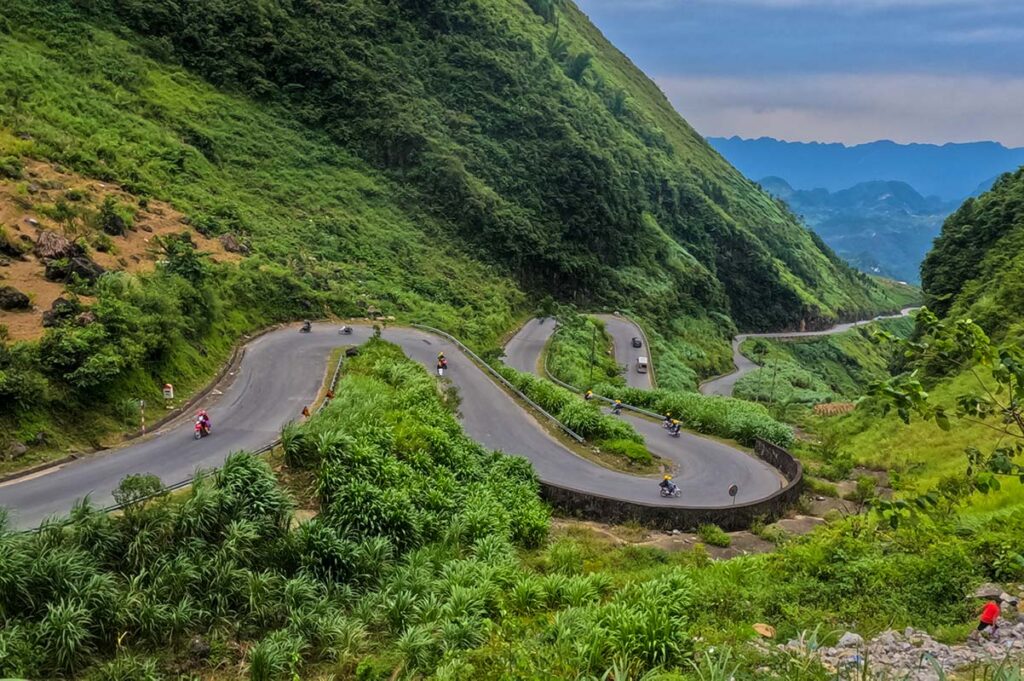About the Tham Ma Pass
Tham Ma Pass is one of the most breathtaking mountain passes along the Ha Giang Loop. Stretching about 5 km in length and situated at an altitude of 1500 meters, it may not be the largest pass in Ha Giang, but its iconic s-shaped zigzagging road makes it a highlight for travelers.

Along this pass, you’ll encounter fascinating geosites with impressive cliffs and rocks. The Hmong hill tribe, an ethnic minority, has adapted remarkably to this rocky area, skillfully utilizing the limited soil for agriculture, cultivating crops like corn and beans. They ingeniously utilize stones for tools and house construction, and their livestock is suited to this challenging climate.
At the pass’s summit, a fantastic vantage point offers an opportunity to capture pictures of the winding s-shaped road below. Often, you’ll encounter local children from the ethnic minorities carrying flowers, adding a charming touch to the scenery.

In the past, Tham Ma Pass was used by locals to test their horses’ strength. They would lead their horses up the mountain pass with heavy loads to assess their capabilities. Horses that performed well were kept, while others were used for Thang Co, a special dish found at farmer’s markets in Ha Giang. However, it is not recommended for inexperienced eaters.
Location of Tham Ma Pass
Tham Ma Pass is situated in Dong Van district, within Ha Giang Province, approximately 10 km from Yen Minh, positioned between the villages of Lung Thau and Van Chai. To experience the pass, you’ll traverse along Highway 4C, which links Ha Giang City and Dong Van town. It stands at a distance of 110 km from Ha Giang City and around 35 km from Dong Van town.
How to get there?
Tham Ma Pass is conveniently included in the Ha Giang Loop, a popular route that takes you through the highlights of Ha Giang province in about 3 to 4 days.
From Hanoi to Ha Giang
Start your journey by traveling from Hanoi to Ha Giang City, which can be easily reached by road. There are night sleeper buses and day limousine buses available, with the journey taking around 6 to 7 hours.
Embarking on the Ha Giang Loop
Upon arrival in Ha Giang, you can commence the Ha Giang Loop. There are three main options to explore the loop:
- Driving a motorbike: This option offers adventure and a sense of freedom, but it is recommended for experienced drivers with the necessary paperwork.
- Riding on the back of a motorbike: This choice still provides a thrilling adventure, but having an experienced guide driving ensures a safer experience and the opportunity to discover hidden gems along the way.
- Going by car: While less adventurous, traveling by car covers the same route and offers added comfort and protection against rain, hot weather, and cold temperatures.
Tham Ma Pass in the Ha Giang Loop
If you are completing the Ha Giang Loop in 3 days, you’ll often visit Tham Ma Pass on the first day while driving from Ha Giang to Dong Van. It is relatively closer to Dong Van, allowing for an afternoon visit.
Other sights around
Just 7 km from Tham Ma Pass, on the way to Dong Van, you will encounter another stunning pass known as the Chin Khoanh Pass.
After conquering this pass, you will enter Sung La Valley, which is particularly enchanting during the buckwheat flower season. In addition, the valley houses a few very old Hmong villages.
Before reaching Dong Van, you can make a stop at the Hmong King Palace, the former residence of the king of the Hmong minority. This historical site offers a glimpse into the cultural heritage of the region.
Tips for visiting the Tham Ma Pass
1. Best time to visit the Tham Ma Pass
Tham Ma Pass offers beautiful scenery throughout the year, but it’s worth considering the weather conditions. The summer months may bring more rain, while the winter months of December and January can be quite cold. For milder temperatures and comfortable travel, consider visiting in the spring or autumn.
2. Staying overnight at Tham Ma Homestay
For those who can’t get enough of the breathtaking views from Tham Ma Pass, there is a unique accommodation option called Tham Ma Homestay, situated higher up in the mountains. This homestay offers a blend of traditional style and modern comfort, providing guests with stunning vistas of the surrounding mountains and the majestic Tham Ma Pass.


